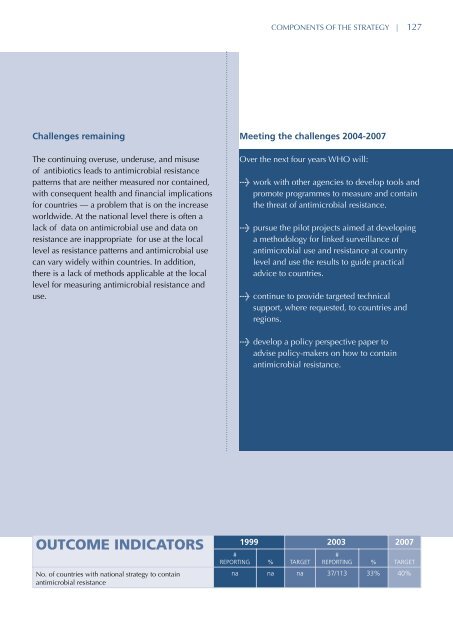who medicines strategy - libdoc.who.int - World Health Organization
who medicines strategy - libdoc.who.int - World Health Organization who medicines strategy - libdoc.who.int - World Health Organization
WHO MEDICINES STRATEGY 2004-2007 | 126EO 7.8Practical approaches to containantimicrobial resistance developedbased on the WHO Global Strategyto Contain Antimicrobial Resistance.RationaleIrrational use of antimicrobials, including theiruse in agriculture, is one of the major driversof increasing antimicrobial resistance. As aresult, some infections are now untreatable withfirst-line antimicrobials in some parts of theworld. Surveys have revealed that 25%-75%of antibiotic prescriptions in teaching hospitalsin both developed and developing countriesare inappropriate. 64 In addition, as many as30%-60% of patients in primary health carecentres receive antibiotics (perhaps twice what isclinically needed). 65 Surveys have also revealedthat most episodes of illness are self-medicatedand that most people purchase incompletecourses of medication, including antibiotics, and/or do not adhere to the correct dosing regimes.ProgressWHO has recognized antimicrobial resistance tobe a problem of increasing public health concernand passed a number of resolutions encouragingMember States to take measures to containantimicrobial resistance 66 . The WHO GlobalStrategy to Contain Antimicrobial Resistanceand other supporting documents were publishedin 2001 67 and a follow-up meeting on how toimplement the Global Strategy held in 2002. EDMhas provided technical assistance in developingnational plans to contain antimicrobial resistancein six countries and three regions. A numberof pilot projects have been started in India andSouth Africa involving the development of amethodology for the linked surveillance ofantimicrobial use and resistance.
COMPONENTS OF THE STRATEGY | 127Challenges remainingThe continuing overuse, underuse, and misuseof antibiotics leads to antimicrobial resistancepatterns that are neither measured nor contained,with consequent health and financial implicationsfor countries — a problem that is on the increaseworldwide. At the national level there is often alack of data on antimicrobial use and data onresistance are inappropriate for use at the locallevel as resistance patterns and antimicrobial usecan vary widely within countries. In addition,there is a lack of methods applicable at the locallevel for measuring antimicrobial resistance anduse.Meeting the challenges 2004-2007Over the next four years WHO will:> work with other agencies to develop tools andpromote programmes to measure and containthe threat of antimicrobial resistance.> pursue the pilot projects aimed at developinga methodology for linked surveillance ofantimicrobial use and resistance at countrylevel and use the results to guide practicaladvice to countries.> continue to provide targeted technicalsupport, where requested, to countries andregions.> develop a policy perspective paper toadvise policy-makers on how to containantimicrobial resistance.OUTCOME INDICATORS1999 2003 2007No. of countries with national strategy to containantimicrobial resistance#REPORTING % TARGET#REPORTING % TARGETna na na 37/113 33% 40%
- Page 88 and 89: WHO MEDICINES STRATEGY 2004-2007 |
- Page 90 and 91: WHO MEDICINES STRATEGY 2004-2007 |
- Page 92 and 93: WHO MEDICINES STRATEGY 2004-2007 |
- Page 94 and 95: WHO MEDICINES STRATEGY 2004-2007 |
- Page 96 and 97: WHO MEDICINES STRATEGY 2004-2007 |
- Page 98 and 99: WHO MEDICINES STRATEGY 2004-2007 |
- Page 100 and 101: WHO MEDICINES STRATEGY 2004-2007 |
- Page 102 and 103: WHO MEDICINES STRATEGY 2004-2007 |
- Page 104 and 105: WHO MEDICINES STRATEGY 2004-2007 |
- Page 106 and 107: WHO MEDICINES STRATEGY 2004-2007 |
- Page 108 and 109: WHO MEDICINES STRATEGY 2004-2007 |
- Page 110 and 111: WHO MEDICINES STRATEGY 2004-2007 |
- Page 112 and 113: WHO MEDICINES STRATEGY 2004-2007 |
- Page 114 and 115: WHO MEDICINES STRATEGY 2004-2007 |
- Page 116 and 117: WHO MEDICINES STRATEGY 2004-2007 |
- Page 118 and 119: WHO MEDICINES STRATEGY 2004-2007 |
- Page 120 and 121: WHO MEDICINES STRATEGY 2004-2007 |
- Page 122 and 123: WHO MEDICINES STRATEGY 2004-2007 |
- Page 124 and 125: WHO MEDICINES STRATEGY 2004-2007 |
- Page 126 and 127: WHO MEDICINES STRATEGY 2004-2007 |
- Page 128 and 129: WHO MEDICINES STRATEGY 2004-2007 |
- Page 130 and 131: WHO MEDICINES STRATEGY 2004-2007 |
- Page 132 and 133: WHO MEDICINES STRATEGY 2004-2007 |
- Page 134 and 135: WHO MEDICINES STRATEGY 2004-2007 |
- Page 136 and 137: WHO MEDICINES STRATEGY 2004-2007 |
- Page 140 and 141: WHO MEDICINES STRATEGY 2004-2007 |
- Page 142 and 143: WHO MEDICINES STRATEGY 2004-2007 |
- Page 144 and 145: WHO MEDICINES STRATEGY 2004-2007 |
- Page 146 and 147: WHO MEDICINES STRATEGY 2004-2007 |
- Page 148 and 149: WHO MEDICINES STRATEGY 2004-2007 |
- Page 150 and 151: WHO MEDICINES STRATEGY 2004-2007 |
- Page 152 and 153: WHO MEDICINES STRATEGY 2004-2007 |
- Page 154 and 155: WHO MEDICINES STRATEGY 2004-2007 |
- Page 157 and 158: REFERENCES
- Page 159 and 160: REFERENCES | 1471Annual report 2000
- Page 161 and 162: REFERENCES | 14912 th Model List of
COMPONENTS OF THE STRATEGY | 127Challenges remainingThe continuing overuse, underuse, and misuseof antibiotics leads to antimicrobial resistancepatterns that are neither measured nor contained,with consequent health and financial implicationsfor countries — a problem that is on the increaseworldwide. At the national level there is often alack of data on antimicrobial use and data onresistance are inappropriate for use at the locallevel as resistance patterns and antimicrobial usecan vary widely within countries. In addition,there is a lack of methods applicable at the locallevel for measuring antimicrobial resistance anduse.Meeting the challenges 2004-2007Over the next four years WHO will:> work with other agencies to develop tools andpromote programmes to measure and conta<strong>int</strong>he threat of antimicrobial resistance.> pursue the pilot projects aimed at developinga methodology for linked surveillance ofantimicrobial use and resistance at countrylevel and use the results to guide practicaladvice to countries.> continue to provide targeted technicalsupport, where requested, to countries andregions.> develop a policy perspective paper toadvise policy-makers on how to containantimicrobial resistance.OUTCOME INDICATORS1999 2003 2007No. of countries with national <strong>strategy</strong> to containantimicrobial resistance#REPORTING % TARGET#REPORTING % TARGETna na na 37/113 33% 40%



